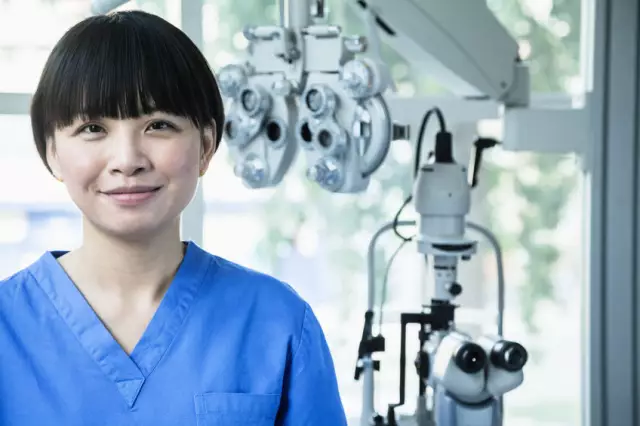- Author Rachel Wainwright [email protected].
- Public 2023-12-15 07:39.
- Last modified 2025-11-02 20:14.
Intimate balance

The vaginal mucosa is the habitat of a large number of bacteria. Some of them perform useful functions - these are "good" lactic acid lactobacilli. But they also have "bad" neighbors - they are called conditionally pathogenic, that is, they do not cause harm as long as they are few. Unauthorized seizure of territory by pathogens occurs when, for some reason, the number of lactobacilli decreases. The microflora of the vagina is disrupted, bacteria multiply rapidly, infectious inflammation develops - bacterial vaginosis.
So why do lactobacilli die?
There are two groups of conditions that predispose to this disease:
The first group is internal factors. These include primarily various hormonal disorders. They lead to changes in the vaginal mucosa, it reduces the production of glycogen - a nutrient medium for lactobacilli. The same happens as a result of metabolic disorders, including obesity, diabetes. Nicotine makes its contribution, and not a small one - among women who smoke, bacterial vaginosis is more common.
The second group is external factors, the use of antibiotics is leading here. These drugs strike all bacteria, including beneficial ones. Spermicides and intrauterine devices violate the microflora of the vagina, and even more - the contraceptive intravaginal ring. It is used for months and, like any foreign body, injures the mucous membrane. Before choosing this method of contraception for yourself, you must make sure that the vaginal microflora is normal.
How to determine the deficiency of lactobacilli?
It is possible to determine the deficiency of lactobacilli in the vagina using an ordinary procedure - a smear, it is done during a gynecological examination. Be sure to measure the pH, acid-alkaline environment in the vagina, using litmus papers. Special gloves for self-diagnosis with a test strip are even sold abroad - a woman herself can control the level of acidity in the vagina.
What if a vaginal infection is found?
Since the late 1980s, Russia has been using a two-stage method of treating bacterial vaginosis and other vaginal infections. First, we destroy pathogenic microbes with antibacterial drugs. The second stage is to populate the vaginal mucosa with lactobacilli. If this is not done, the "bad" microbes will multiply again. With this two-stage approach, treatment efficacy is greater than 90%.
Is it possible to find the infection myself?
Sure. An unpleasant odor, abundant discharge, and even more itching and burning, must be alerted. But not all women pay attention to this, and as a result, doctors can deal with advanced diseases that last for 5-10 years or more.
How can we restore the vaginal microflora again?
Not so long ago, our mothers and grandmothers used sauerkraut to treat vaginal dysbiosis, or they inserted tampons soaked in kefir into the vagina, and even doused with a solution of lemon juice! Acylact became the first domestic development designed to restore the normal microflora of the vagina. The drug was very inexpensive and accessible, and had to fight vaginal dysbiosis, but its effectiveness left much to be desired - the lactobacilli contained in the acylact were not viable. The acylact production technology - the hot drying method - destroyed lactobacilli already at the production stage!
What can we say about drugs for the treatment of intestinal dysbiosis - the result was the same - intestinal bacteria in the vagina do not take root!
The next generation of drugs for the treatment of vaginal dysbiosis was a synthetic acidifier - it was believed that to restore normal microflora, it was enough to create an acidic environment in the vagina, and the dysbiosis would go away by itself! But an acidic environment is loved not only by lactobacilli, but also by mushrooms, and in the absence of a sufficient number of beneficial microbes, thrush developed.

Further research in the field of treatment of vaginal dysbiosis showed that the colonization of lactobacilli is possible only in favorable conditions for them, that is, a healthy vaginal mucosa. This knowledge formed the basis for the creation of a new generation Swiss drug - Gynoflor E, which contains, in addition to viable lactobacilli, a micro dose of the female hormone estriol. The dose of estriol in Gynoflora E is optimal for women at any age, it is 3 hundredths of a milligram that can restore the vaginal mucosa without affecting the entire body.
The use of Gynoflora E in the correct sequence - after therapy with antimicrobial drugs - allows you to get rid of vaginal infections completely and without relapse! The unique action of Gynoflora E - the simultaneous restoration of the vaginal mucosa, and the settlement of live lactobacilli - will return you intimate health.
Due to its ease of use - 1 vaginal tablet at night for 6 or 12 days, high efficiency and the absence of side effects - the drug has gained real popularity among both gynecologists and their patients.
Found a mistake in the text? Select it and press Ctrl + Enter.






